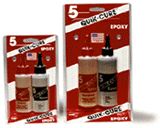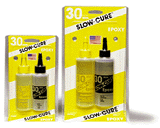|
|
|
|
|
Go
To: |
|
|
|
|
|
|
|
Information: |
|
|
|
|
|
|
| |
|
|
JOIN THE
AMERICAN
KITEFLIERS
ASSOCIATION

GET A 10%
DISCOUNT! |
|
|
| |
|
|
|
|
| |
|
|
 |
 |
|
 |
|
|
| Kite
Studio
Epoxy Glue |
 |
QUIK-CURE™
5 min. epoxy cures
to a slightly flexible consistency. This lack of
brittleness allows it to form a lasting bond in areas
subjected to high vibration or stress. QUIK-CURE™
shouldn’t be used in areas that are subject to
long-term immersion in water; however, it works fine for
the internal structure of wood framed boats. QUIKCURE™
is our only epoxy on which you can apply polyester
resins. It can be mixed with microballoons to form a
quick setting putty. Items bonded with QUIK-CURE™
can be handled after 15 minutes. Full strength is reached
in 1 hour.
|
|
 |
|
SLOW-CURE™ 30 min. epoxy works best for forming
reinforcing fillets on joints. It has the highest strength
of our epoxies. It is waterproof and more heat resistant.
SLOW-CURE™ can be used for bonding if you’re willing to
wait overnight. Fillers such as microballoons can be mixed
with SLOW-CURE™ and FINISH-CURE™ to form a putty-like
consistency. Such fillers will usually decrease the
working time by about 25%. Bonded objects can be handled
after 8 hours and the cured epoxy reaches full strength
within 24 hours.
|
|
Secure On-Line
Shopping: |
|
|
|
|
|
|
|
How
to use Epoxy Glue:
If CAs are the
cure-all for just about all bonding problems, you may be
wondering, "Why do I need epoxy?" One primary reason is
price. Epoxy costs are about one fourth that of CA. When large
objects are being bonded, economics can be a deciding factor on
choice of adhesive. The specific characteristics of epoxies also
give them advantages in some applications. All our epoxies are
mixed with a 50-50 ratio. Any scrap material or paper scratch pad
can be used as a mixing surface. We have found, however, that the
plastic tops to coffee cans work best due to their outer border
and their flexibility, which allows the unused cured epoxy to be
released and thrown away.
Squeeze out equal
length beads of the desired amount of epoxy, then mix together
thoroughly with a Popsicle stick or scrap piece of material. In
cold weather, epoxy takes longer to cure (too cold and usually
they never fully cure) and becomes more difficult to get out of
the bottle, especially if it’s less than 1/2 full. The
epoxies can be heated in a microwave oven for about 10 seconds so
that they flow easier. The heating process, with the caps off,
also releases any moisture that can be absorbed by epoxies. Their
shelf life, therefore, is virtually unlimited.
Acetone works as
the best solvent for cleaning epoxy from brushes and unwanted
surfaces before it cures. If epoxy gets on surfaces that acetone
will attack, use isopropyl alcohol. We do not recommend any
additives for thinning epoxies due to their effect on curing and
overall strength. If thin epoxy is required, either use heat or
switch to EX-SLOW™ or FINISH-CURE™. Epoxies bond best
to clean, textured surfaces. Smooth, non-porous surfaces should
be roughened with coarse sandpaper to improve adhesion.
A small amount of
CA can be used in strategic locations to hold parts in place
while the epoxies cure. The minute designations for epoxies refer
to the working time, i.e., the time one has before the epoxies
begin to set up after being mixed in a large mass. When spread
into thinner layers, the working time in increased significantly
(except QUIK-CURE™). Working time decreases approximately
25% at temperatures above 90 degrees F. Don’t panic if your
skin comes in contact with either epoxy or CA.
While contact
should be avoided, uncured epoxy can be washed from your skin
with soap and water. Allergic reactions are rare. Cured epoxy and
CA can be peeled off the skin and usually are gone after a full
day of normal activity. UN-CURE™ will debond any body parts
that get stuck together if a peeling action (never pulling) doesn’t
part them.
|
|
|
|
|
|
|
COPY OF A
REC.KITES POSTING IN RESPONSE TO "How do I glue
fittings?"
by
Steve Ferrel
Hey all,
Beginning my first, and definitely not the last, adventure into
repairing my
kite and I needed some advice as to what sort of glue to hold on
the end
caps, nocks, ferrules, and spreader connector stoppers to the
fiberglass
rod.
Thanks in advance,
Jasoomian
~~~~~~~~~~~~~~~
Hey Jasoomian,
welcome to the group! Most often I am in a hurry to glue
parts so I usually use a good, fresh CA glue (super glue).
However for
ferrel's, I feel an epoxy is better. My father did a tech
sheet for
www.kitebuilder.com ("Fittings, and how
they work") and part of it
references how to glue ferrels and is relevant to your
question. An excerpt
follows:
---
<snip>
STEP ONE: Prepare the surface. Most important step. Clean the
part where the
glue goes. If it's external use fine sandpaper. If it's internal,
use a
internal rod cleaning brush (TOOL61) and rubbing alcohol, clean
the dust and
mandrel release agent out of the inside of the stick. Let it
dry. Now you
can apply the glue. You have 2 choices: CA /super glue; or, 2
part epoxy.
First, CA or super glue, available in 2 thickness'. Water thin
GLU05, and medium
GLU06. The correct thickness to use is
dependent on the
fit. Tight fit, use thin glue. Loose fit, use thick glue. And
finally, after you apply the glue, give the joint a spray with
Insta-set
ACC10, a cure accelerator which instantly holds the joint,
allowing the rest
of the glue to cure without movement giving you the
strongest joint
possible with CA glue.
Second, Epoxy, 5 minute TWS70 or 30 minute TWS12. Super strong, 2
ton, 30
minute stuff, takes 30 minutes to cure. Since I'm building
kites, not
rockets, the only time I use it is for tow points or
extremely high stress
points. The rest of the time, which is most of the time, I use
the 5 minute
stuff which is my glue of choice. The stuff is a little stinky
while its
wet, but you get used to it. Using a spatula or wood popsicle
stick and a
piece of oaktag, squeeze out equal parts of A & B, mix well,
you now have 5
minutes till hard. Reason most people do not like it , it's
messy. Here
is the secret. You need a bottle of rubbing alcohol from the
drugstore, and
paper towels.
When the glue is wet, it comes off with a paper towel soaked in
rubbing alcohol.
|


